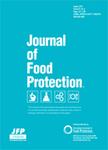版权所有:内蒙古大学图书馆 技术提供:维普资讯• 智图
内蒙古自治区呼和浩特市赛罕区大学西街235号 邮编: 010021

作者机构:Univ Botswana & Swaziland Dept Biol Sci Gaborone Botswana
出 版 物:《JOURNAL OF FOOD PROTECTION》 (食品保护杂志)
年 卷 期:2000年第63卷第1期
页 面:137-140页
核心收录:
学科分类:0832[工学-食品科学与工程(可授工学、农学学位)] 08[工学] 0836[工学-生物工程]
主 题:曲霉菌属/分离和提纯 博茨瓦纳 毛壳菌属/分离和提纯 镰刀菌属/分离和提纯 肠/微生物学 幼虫/微生物学 有丝分裂孢子真菌/分离和提纯 蛾/微生物学 毛霉菌属/分离和提纯 动物
摘 要:Phane worm (an edible larval stage of the emperor moth Imbrasia belina Westwood) is an important food source, and its harvesting is an economic activity in rural Botswana. When the larva is feeding on leaves and later during processing, phane gets contaminated with fungi from the leaves and soil. We examined 73 jars, each containing approximately 608 g (+/-0.25 g) of processed phane stored under laboratory conditions (temperature range 20 to 24 degrees C and 50 to 80% relative humidity) and combined intestinal contents of five phane squeezed into each of 74 Duran bottles for fungi. Ninety seven percent of 74 samples of intestinal contents and 57.5% of 73 laboratory-stored phane were positive for either molds and/or yeasts. Yeast population in intestinal contents ranged from 2 x 10(1) CFU/g to 5 x 10(3) CFU/g, whereas molds ranged from 1 x 10(1) CFU/g to 2 x 10(2) CFU/g. Laboratory-stored phane had a mold population of 1 x 10(2) CFU/g to 6 x 10(5) CFU/g. Species of Chaetomium 13.8%, Aspergillus 12.4%, Fusarium 5.5%, and Mucor racemosus 4.1% were the most prevalent in intestinal contents of phane, whereas Aspergillus 42.1%, Penicillium 33.9%, and Mucorales 5.7% were predominant in laboratory-stored phane. The important mycotoxigenic fungi A. flavus, A. parasiticus, A. ochraceus, P. aurantiogriseum, P. citrinum, and P. verrucosum were isolated mainly from the laboratory-stored phane. The genera isolated from both intestinal phane contents and laboratory-stored phane were Alternaria, Aspergillus, Chaetomium, Drechslera, Fusarium, Mucor, Phoma, and Penicillium, suggesting recontamination of phane during drying and storage.